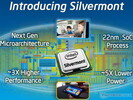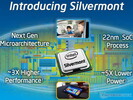Intel Atom Z3770D vs Intel Atom Z3775
Intel Atom Z3770D
► remove from comparison
Der Intel Atom Z3770D ist ein sparsamer Quad-Core-SoC für Windows- und Android-Tablets. Er taktet mit 1,5 bis 2,4 GHz (Turbo) und gehört der Bay Trail-T Plattform an. Dank eines speziell für Low-Power-Chips optimierten 22-Nanometer-Prozesses (P1271) mit Tri-Gate-Transistoren konnte die Performance sowie die Energieeffizienz gegenüber dem Vorgänger deutlich gesteigert werden. Vom Z3770 unterscheidet sich der Chip durch ein anderes Speicherinterface und eine niedrigere maximale Displayauflösung.
Architektur
Die Prozessorkerne basieren auf der neuen Silvermont-Architektur, welche erstmals bei einem Atom-Prozessor als Out-of-order-Design ausgeführt wurde. Die dadurch erhöhte Auslastung der Pipeline sowie viele weitere Detailverbesserungen (optimierte Sprungvorhersage, vergrößerte Buffer, verbesserte Decoder) sollen die Pro-MHz-Leistung um etwa 50 Prozent steigern. Gleichzeitig entfällt allerdings das Hyper-Threading-Feature der Vorgängermodelle. Weitere wichtige Änderungen umfassen die Unterstützung neuer Befehlssatzerweiterungen wie SSE 4.1 und 4.2 sowie AES-NI (modellabhängig).
Performance
Dank 4 CPU-Kernen und einer Taktrate von 1,5 bis 2,4 GHz übertrifft die Performance bisherige Atom-Modelle wie den Z2760 deutlich. In Single- und Multithread-Benchmarks übertrifft der Z3770D sogar einige Kabini-APUs wie den AMD A4-5000, sodass ausreichende Leistungsreserven für die meisten Office- und Multimedia-Anwendungen bestehen. Lediglich anspruchsvollere Windows-Software dürfte den SoC überfordern. Im Android-Bereich zählt der Z3770D zu den absoluten High-End-Modellen und schlägt sogar Tegra 4 und den Snapdragon 800 von Qualcomm.
Grafik
Die HD Graphics (Bay Trail) basiert auf Intels-Gen7-Architektur, welche DirectX 11 unterstützt und auch bei den Grafiklösungen der Ivy-Bridge-Serie (z.B. HD Graphics 4000) zum Einsatz kommt. Mit nur 4 EUs und einer Taktrate von maximal 688 MHz fällt die Leistung aber noch deutlich niedriger als bei der HD Graphics (Ivy Bridge) aus, sodass nur ältere und weniger anspruchsvolle Windows-Spiele flüssig dargestellt werden. Obwohl selbst dies ein drastischer Fortschritt gegenüber dem Vorgänger ist, reicht die GPU-Performance nicht ganz an konkurrierende AMD-APUs (mit höherer TDP) heran. Im Android-Segment ist die Leistung etwa mit einer Adreno 320 vergleichbar. Videobeschleunigung und die Ansteuerung von Displays mit bis zu 1.920 x 1.200 Pixeln bewältigt die GPU hingegen problemlos.
Leistungsaufnahme
Der gesamte SoC wird von Intel mit einer SDP von 2,2 Watt spezifiziert, was einer TDP von maximal 4 Watt entsprechen dürfte. Damit kann der Chip in passiv gekühlten Tablets eingesetzt werden.
Intel Atom Z3775
► remove from comparison
Der Intel Atom Z3775 ist ein sparsamer Quad-Core-SoC für Windows- und Android-Tablets. Er taktet mit 1,46 bis 2,39 GHz (Turbo) und gehört der Bay Trail-T Plattform an. Dank eines speziell für Low-Power-Chips optimierten 22-Nanometer-Prozesses (P1271) mit Tri-Gate-Transistoren konnte die Performance sowie die Energieeffizienz gegenüber dem Vorgänger deutlich gesteigert werden. Vom Z3770 unterscheidet sich der Chip durch das neuere C0-Stepping sowie eine gesteigerte GPU-Taktrate.
Architektur
Die Prozessorkerne basieren auf der neuen Silvermont-Architektur, welche erstmals bei einem Atom-Prozessor als Out-of-order-Design ausgeführt wurde. Die dadurch erhöhte Auslastung der Pipeline sowie viele weitere Detailverbesserungen (optimierte Sprungvorhersage, vergrößerte Buffer, verbesserte Decoder) sollen die Pro-MHz-Leistung um etwa 50 Prozent steigern. Gleichzeitig entfällt allerdings das Hyper-Threading-Feature der Vorgängermodelle. Weitere wichtige Änderungen umfassen die Unterstützung neuer Befehlssatzerweiterungen wie SSE 4.1 und 4.2 sowie AES-NI (modellabhängig).
Performance
Dank 4 CPU-Kernen und einer Taktrate von 1,46 bis 2,39 GHz übertrifft die Performance bisherige Atom-Modelle wie den Z2760 deutlich. In Single- und Multithread-Benchmarks schlägt der Z3775 sogar einige Kabini-APUs wie den AMD A4-5000, sodass ausreichende Leistungsreserven für die meisten Office- und Multimedia-Anwendungen bestehen. Lediglich anspruchsvollere Windows-Software dürfte den SoC überfordern. Im Android-Bereich zählt der Z3775 zur High-End-Klasse und schlägt sogar Tegra 4 und den Snapdragon 800 von Qualcomm.
Grafik
Die HD Graphics (Bay Trail) basiert auf Intels-Gen7-Architektur, welche DirectX 11 unterstützt und auch bei den Grafiklösungen der Ivy-Bridge-Serie (z.B. HD Graphics 4000) zum Einsatz kommt. Mit nur 4 EUs und einer Taktrate von bis zu 778 MHz fällt die Leistung aber noch deutlich niedriger als bei der HD Graphics (Ivy Bridge) aus, sodass nur ältere und weniger anspruchsvolle Windows-Spiele flüssig dargestellt werden. Obwohl selbst dies ein drastischer Fortschritt gegenüber dem Vorgänger ist, reicht die GPU-Performance nicht ganz an konkurrierende AMD-APUs (mit höherer TDP) heran. Videobeschleunigung und die Ansteuerung von Displays mit bis zu 2.560 x 1.600 Pixeln bewältigt die GPU hingegen problemlos. Im Android-Segment ist die Leistung etwa mit einer Adreno 320 vergleichbar.
Leistungsaufnahme
Der gesamte SoC wird von Intel mit einer SDP von 2 Watt spezifiziert, was einer TDP von unter 4 Watt entsprechen dürfte. Damit kann der Chip in passiv gekühlten Tablets eingesetzt werden.
| Model | Intel Atom Z3770D | Intel Atom Z3770D | Intel Atom Z3775 | ||||||||||||||||||||||||||||||||||||||||||||||||||||||||||||||||||||||||||||||||||||||||||||||||||||||||||||||||||||||||||||||||||||||||||||||||||||||||||||||||||||||||||||||||||||||||||||||||||||||||||||||||||||||||
| Codename | Bay Trail-T | Bay Trail-T | Bay Trail-T | ||||||||||||||||||||||||||||||||||||||||||||||||||||||||||||||||||||||||||||||||||||||||||||||||||||||||||||||||||||||||||||||||||||||||||||||||||||||||||||||||||||||||||||||||||||||||||||||||||||||||||||||||||||||||
| Series | Intel Atom | Intel Atom | Intel Atom | ||||||||||||||||||||||||||||||||||||||||||||||||||||||||||||||||||||||||||||||||||||||||||||||||||||||||||||||||||||||||||||||||||||||||||||||||||||||||||||||||||||||||||||||||||||||||||||||||||||||||||||||||||||||||
| Serie: Atom Bay Trail-T |
|
|
| ||||||||||||||||||||||||||||||||||||||||||||||||||||||||||||||||||||||||||||||||||||||||||||||||||||||||||||||||||||||||||||||||||||||||||||||||||||||||||||||||||||||||||||||||||||||||||||||||||||||||||||||||||||||||
| Clock | 1500 - 2410 MHz | 1500 - 2410 MHz | 1460 - 2390 MHz | ||||||||||||||||||||||||||||||||||||||||||||||||||||||||||||||||||||||||||||||||||||||||||||||||||||||||||||||||||||||||||||||||||||||||||||||||||||||||||||||||||||||||||||||||||||||||||||||||||||||||||||||||||||||||
| L1 Cache | 224 KB | 224 KB | 224 KB | ||||||||||||||||||||||||||||||||||||||||||||||||||||||||||||||||||||||||||||||||||||||||||||||||||||||||||||||||||||||||||||||||||||||||||||||||||||||||||||||||||||||||||||||||||||||||||||||||||||||||||||||||||||||||
| L2 Cache | 2 MB | 2 MB | 2 MB | ||||||||||||||||||||||||||||||||||||||||||||||||||||||||||||||||||||||||||||||||||||||||||||||||||||||||||||||||||||||||||||||||||||||||||||||||||||||||||||||||||||||||||||||||||||||||||||||||||||||||||||||||||||||||
| Cores / Threads | 4 / 4 | 4 / 4 | 4 / 4 | ||||||||||||||||||||||||||||||||||||||||||||||||||||||||||||||||||||||||||||||||||||||||||||||||||||||||||||||||||||||||||||||||||||||||||||||||||||||||||||||||||||||||||||||||||||||||||||||||||||||||||||||||||||||||
| TDP | 4 Watt | 4 Watt | 4 Watt | ||||||||||||||||||||||||||||||||||||||||||||||||||||||||||||||||||||||||||||||||||||||||||||||||||||||||||||||||||||||||||||||||||||||||||||||||||||||||||||||||||||||||||||||||||||||||||||||||||||||||||||||||||||||||
| Technology | 22 nm | 22 nm | 22 nm | ||||||||||||||||||||||||||||||||||||||||||||||||||||||||||||||||||||||||||||||||||||||||||||||||||||||||||||||||||||||||||||||||||||||||||||||||||||||||||||||||||||||||||||||||||||||||||||||||||||||||||||||||||||||||
| Socket | UTFCBGA1380 | UTFCBGA1380 | UTFCBGA1380 | ||||||||||||||||||||||||||||||||||||||||||||||||||||||||||||||||||||||||||||||||||||||||||||||||||||||||||||||||||||||||||||||||||||||||||||||||||||||||||||||||||||||||||||||||||||||||||||||||||||||||||||||||||||||||
| Features | Intel HD Graphics (Bay Trail, 313 - 688 MHz), Quick Sync, Wireless Display, Clear Video HD, Intel 64, SSE 4.1, SSE 4.2, AES-NI, Secure Key, Anti-Theft, Identify-Protection, max. 2 GB Single-Channel DDR3L-RS 1333, Quick Sync | Intel HD Graphics (Bay Trail, 313 - 688 MHz), Quick Sync, Wireless Display, Clear Video HD, Intel 64, SSE 4.1, SSE 4.2, AES-NI, Secure Key, Anti-Theft, Identify-Protection, max. 2 GB Single-Channel DDR3L-RS 1333, Quick Sync | Intel HD Graphics (Bay Trail, 311 - 778 MHz), Quick Sync, Wireless Display, Clear Video HD, Intel 64, SSE 4.1, SSE 4.2, AES-NI, Secure Key, Anti-Theft, Identify-Protection, max. 4 GB Dual-Channel LPDDR3-1067 | ||||||||||||||||||||||||||||||||||||||||||||||||||||||||||||||||||||||||||||||||||||||||||||||||||||||||||||||||||||||||||||||||||||||||||||||||||||||||||||||||||||||||||||||||||||||||||||||||||||||||||||||||||||||||
| iGPU | Intel HD Graphics (Bay Trail) (313 - 688 MHz) | Intel HD Graphics (Bay Trail) (313 - 688 MHz) | Intel HD Graphics (Bay Trail) (311 - 778 MHz) | ||||||||||||||||||||||||||||||||||||||||||||||||||||||||||||||||||||||||||||||||||||||||||||||||||||||||||||||||||||||||||||||||||||||||||||||||||||||||||||||||||||||||||||||||||||||||||||||||||||||||||||||||||||||||
| Architecture | x86 | x86 | x86 | ||||||||||||||||||||||||||||||||||||||||||||||||||||||||||||||||||||||||||||||||||||||||||||||||||||||||||||||||||||||||||||||||||||||||||||||||||||||||||||||||||||||||||||||||||||||||||||||||||||||||||||||||||||||||
| $37 U.S. | $37 U.S. | $35 U.S. | |||||||||||||||||||||||||||||||||||||||||||||||||||||||||||||||||||||||||||||||||||||||||||||||||||||||||||||||||||||||||||||||||||||||||||||||||||||||||||||||||||||||||||||||||||||||||||||||||||||||||||||||||||||||||
| Announced | |||||||||||||||||||||||||||||||||||||||||||||||||||||||||||||||||||||||||||||||||||||||||||||||||||||||||||||||||||||||||||||||||||||||||||||||||||||||||||||||||||||||||||||||||||||||||||||||||||||||||||||||||||||||||||
| Manufacturer | ark.intel.com | ark.intel.com | ark.intel.com |
Benchmarks
Average Benchmarks Intel Atom Z3775 → 0% n=0
* Smaller numbers mean a higher performance
1 This benchmark is not used for the average calculation













